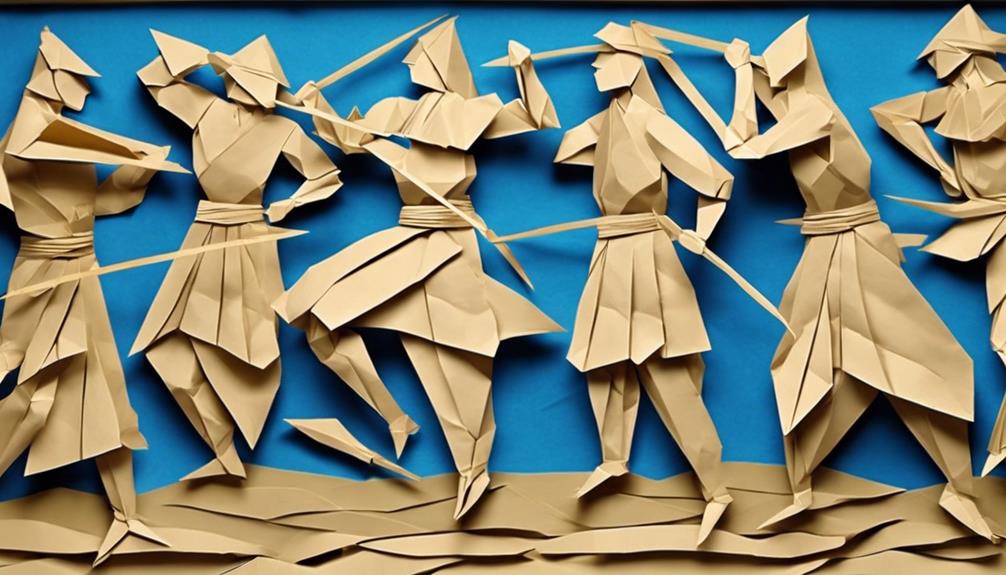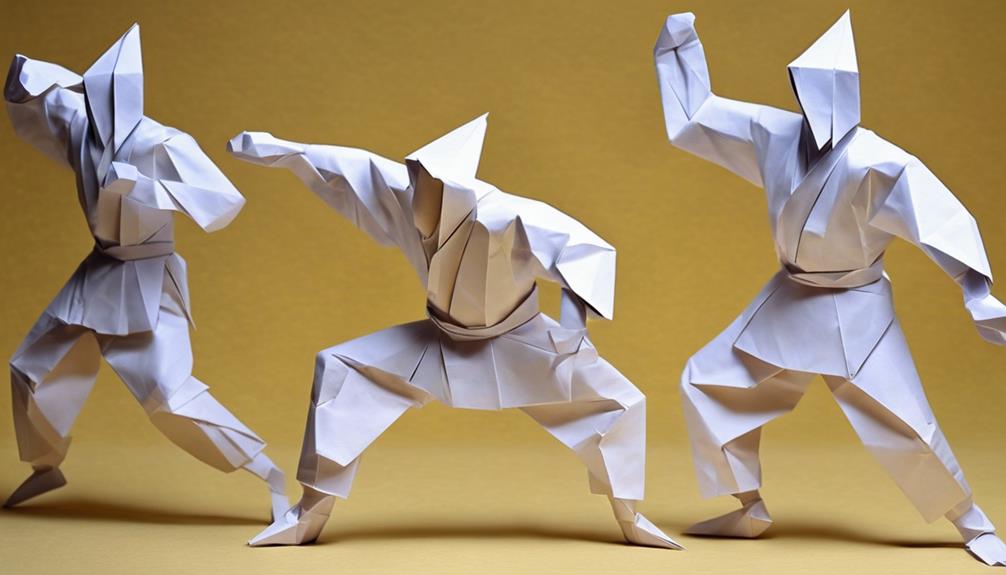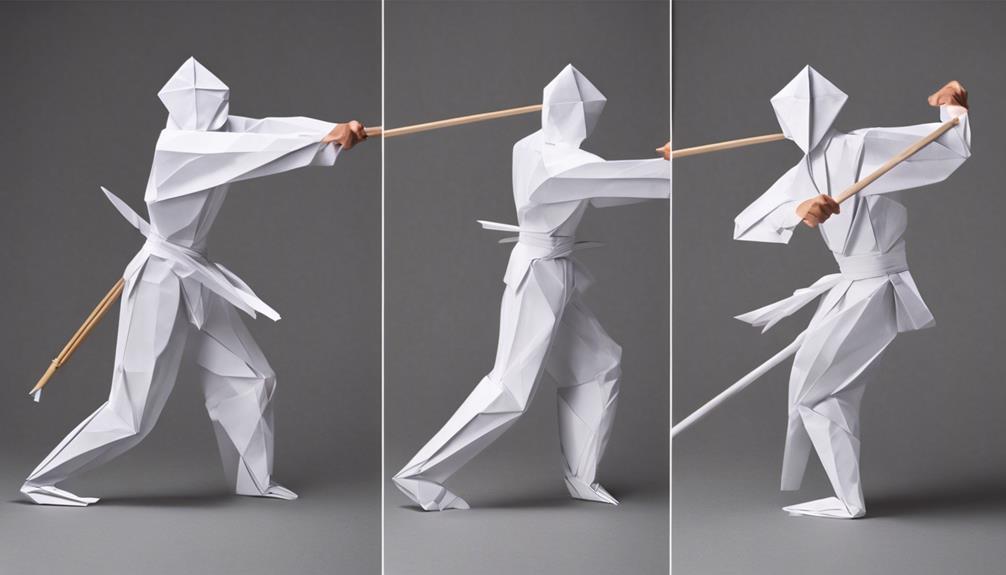General Rules of Silambam
When it comes to mastering the art of Silambam, understanding the general rules is crucial for your progress and development. From the intricate footwork to the precise weapon handling techniques, every aspect plays a significant role in honing your skills. These rules not only dictate how you move and strike but also encompass a deeper level of discipline and respect that is essential in this ancient martial art. So, let's explore the foundational principles that govern the practice of Silambam and pave the way for your journey towards mastery.
Origins of Silambam

The origins of Silambam can be traced back to ancient South India, where it was developed as a traditional martial art form. This art holds immense historical significance and has left a profound cultural impact on the region. Silambam was not merely a combat technique but a way of life for many in South India, influencing various aspects of their society and daily routines. The techniques and philosophies embedded within Silambam were passed down through generations, preserving the heritage of the art form.
The evolution of Silambam techniques has been a continuous process, adapting to modern applications while staying true to its roots. Over time, practitioners have refined and expanded upon the traditional movements, incorporating new strategies and training methods to enhance both offensive and defensive capabilities. The art has found relevance not only in self-defense scenarios but also in promoting physical fitness, mental discipline, and overall well-being.
Silambam's historical significance and cultural impact have paved the way for its recognition on a global scale. As more people embrace the art form, its influence continues to grow, fostering a sense of unity and respect among practitioners worldwide. By understanding the rich history and evolution of Silambam, individuals can appreciate the art form beyond its physical aspects, delving into its spiritual and cultural depths for liberation and enlightenment.
Etiquette and Respect in Silambam
When practicing Silambam, observing proper etiquette is crucial for fostering a respectful environment. Showing respect towards your instructors is fundamental in the Silambam tradition. Understanding and upholding these etiquettes play a significant role in the overall learning experience.
Etiquette in Silambam Practice
Practicing Silambam requires a deep understanding of etiquette and respect towards the art and fellow practitioners. Training etiquette holds immense cultural significance, emphasizing the values of discipline and self-control in practice. When engaging in Silambam, it is crucial to adhere to the established customs and rituals that have been passed down through generations, as they reflect the rich heritage of this martial art form. Showing respect towards your training space, instructors, and peers not only fosters a harmonious practice environment but also cultivates a sense of humility and mindfulness. By embodying these principles of etiquette, you not only honor the tradition of Silambam but also contribute to your own growth and development within this ancient art.
Respect for Instructors
How can one effectively demonstrate respect for instructors in Silambam practice? In Silambam, showing respect for instructors is paramount. Recognizing instructor authority is essential, as they possess knowledge and experience crucial for your growth. Display respect by actively listening to instructions, following guidance promptly, and acknowledging their expertise. Student obedience is not just about following commands but also about valuing the wisdom and skills the instructors impart. Address them with the appropriate title and maintain a humble attitude during training sessions. By honoring your instructors, you not only show appreciation for their dedication but also create a positive learning environment that fosters growth and development in Silambam practice.
Basic Stances and Footwork

To establish a solid foundation in Silambam, mastering the basic stances and footwork is crucial. These fundamental elements form the backbone of your practice, enhancing your balance, agility, and overall performance. Let's delve into the essential stances and footwork techniques that will set you on the path to mastery.
—
Basic Stances and Footwork
In Silambam, a combination of proper stances and precise footwork is vital for executing techniques effectively. Here are some key stances and footwork patterns along with their descriptions:
| Stance | Description |
|---|---|
| Samanam | Equal stance on both legs, ready position |
| Mukkadam | Front stance, one leg forward, one leg back |
| Viram | Defensive stance, sideways, knees bent |
| Footwork | Description |
| Vattam | Circular footwork, moving in a circular pattern |
| Ner | Forward step with one foot |
| Uri | Backward step with one foot |
Essential Techniques for Beginners
Understanding the foundational techniques in Silambam is key for beginners looking to develop a strong grasp of the art form. Two essential elements that beginners must focus on are maintaining a proper grip on the Silambam stick and adopting the correct stance.
First and foremost, mastering the proper grip is crucial in Silambam. The grip should be firm yet flexible, allowing you to control the stick effectively while also enabling fluid movements. Beginners should ensure that the grip is neither too tight, which can restrict movement, nor too loose, which can lead to the stick slipping from your grasp during practice sessions.
Secondly, beginners need to pay close attention to their stance. The correct stance in Silambam provides a solid foundation for executing various techniques with precision and power. Your feet should be shoulder-width apart, with one foot slightly in front of the other to maintain balance and stability. Additionally, your body should be aligned with the direction you intend to strike, enabling you to generate maximum force and accuracy in your movements.
Importance of Focus and Concentration

When practicing Silambam, focusing your mind is crucial for enhancing mental clarity, ensuring precision in your movements, and achieving mind-body synchronization. By honing your concentration skills, you will be able to execute techniques with more accuracy and efficiency. The ability to maintain focus throughout your practice sessions will not only improve your physical performance but also cultivate a deeper connection between your mind and body.
Enhancing Mental Clarity
Enhancing mental clarity in Silambam practice involves honing your focus and concentration to achieve precision in movements and techniques. Improving mindfulness is crucial as it allows you to be fully present in each moment of your practice. By enhancing concentration, you can better control your thoughts and emotions, leading to a deeper connection between your mind and body. Through focused attention, you can sharpen your awareness of body mechanics, timing, and positioning, which are essential for mastering Silambam. Cultivating mental clarity not only improves your performance but also promotes a sense of inner peace and balance. Embrace the journey of refining your focus and concentration, as it is a fundamental step towards unlocking the full potential of your Silambam practice.
Precision in Movements
To achieve mastery in Silambam, your focus and concentration must be honed to a razor-sharp precision in every movement and technique. Movement precision is crucial as it ensures that each strike, block, or footwork is executed with accuracy and effectiveness. Balance plays a vital role in maintaining stability and control throughout the practice. Timing is key in Silambam, where the coordination between your movements and your opponent's actions can determine the outcome of a confrontation. Coordination between different parts of your body is essential to perform complex maneuvers seamlessly. By focusing intensely on each movement, you cultivate a heightened awareness that allows you to respond swiftly and decisively, embodying the art of Silambam with grace and power.
Mind-Body Synchronization
Achieving optimal mind-body synchronization in Silambam requires unwavering focus and unyielding concentration throughout each movement and technique. Breath control plays a vital role in enhancing this synchronization, allowing you to maintain your energy levels and stay focused during intense training sessions. Developing physical strength is equally important, as it not only improves your overall performance but also enhances your ability to synchronize your mind and body effectively. Coordination is key in Silambam, as it enables you to execute complex movements seamlessly while staying in sync with your breath and maintaining focus. Additionally, honing your reaction time through consistent practice will further enhance your mind-body synchronization, allowing you to respond swiftly and accurately to any situation that arises during training or combat.
Advancing to Intermediate Level

As you progress in your Silambam training, reaching the intermediate level requires mastering foundational techniques and developing a deeper understanding of the art's principles. Advanced drills and technique refinement are crucial aspects of advancing in Silambam. To progress effectively, focus on perfecting your strikes, footwork, and defensive maneuvers. Consistency and dedication to practice are key to mastering these skills.
| Advanced Drills | Technique Refinement | Physical Conditioning |
|---|---|---|
| Circular Strike Drills | Precision in Strikes | Endurance Training |
| Footwork Patterns | Defensive Techniques | Strength Building |
| Speed and Accuracy Drills | Form and Posture Improvement | Flexibility Exercises |
Advanced drills like circular strike drills help in enhancing your coordination and speed. These drills also aid in developing the fluidity of your movements, which is essential for intermediate level proficiency. Technique refinement involves focusing on the precision of your strikes and defensive techniques. Pay attention to details such as the angle of your strikes and the timing of your blocks.
Physical conditioning plays a vital role in preparing you for the challenges of the intermediate level. Endurance training, strength building, and flexibility exercises are necessary to improve your overall physical fitness. By incorporating these elements into your training regimen, you will be better equipped to handle the demands of Silambam at the intermediate level.
Sparring and Combat Strategies
Understanding sparring and combat strategies in Silambam is essential for developing practical application skills in real-life scenarios. In Silambam, sparring techniques focus on honing your defensive strategies while combat drills emphasize offensive maneuvers. When engaging in sparring, it's crucial to master defensive strategies such as blocking, parrying, and evasion. These techniques not only help you protect yourself but also create openings for counterattacks. By incorporating footwork into your defensive strategies, you can effectively control the distance between you and your opponent, giving you an advantage in combat situations.
Combat drills in Silambam are designed to enhance your offensive maneuvers, including strikes, thrusts, and combinations. Practicing these drills helps improve your speed, accuracy, and timing, making your attacks more effective and unpredictable. It is essential to focus on both precision and power when executing offensive maneuvers to maximize their impact on your opponent.
Incorporating both defensive strategies and offensive maneuvers into your training routine will not only make you a well-rounded Silambam practitioner but also better prepared for real-life self-defense scenarios. Remember, mastering sparring and combat strategies takes time, dedication, and consistent practice, but the skills you develop will be invaluable in your journey towards liberation through Silambam.
Weapon Handling and Safety Measures

When handling a weapon in Silambam, proper grip techniques are crucial for effective strikes and defense. Additionally, understanding the protective gear needed ensures safety during training and combat scenarios. Mastering these aspects not only enhances your performance but also reduces the risk of injuries while practicing Silambam.
Grip Techniques
Proper grip techniques are crucial for effective weapon handling and ensuring safety measures in Silambam practice. To enhance your skills and protect yourself during training, focus on the following:
- Hand Positioning and Alignment: Position your hands correctly on the Silambam stick to maintain control and precision. Align your fingers along the grip for a firm hold and better maneuverability.
- Wrist Flexibility and Strength: Develop wrist flexibility to execute various strikes smoothly. Strengthening your wrist muscles is essential to wield the weapon powerfully without risking injuries.
- Grip Pressure: Find the right balance of grip pressure. Avoid gripping too tightly, as it can lead to fatigue, but ensure a firm enough hold to prevent the weapon from slipping during movements.
Protective Gear Needed
For the optimal handling of weapons and ensuring safety in Silambam practice, it is essential to have the appropriate protective gear. Mandatory equipment for Silambam includes a helmet to protect your head from accidental impacts during training. Additionally, wearing hand guards is crucial to shield your hands and fingers from potential injuries while practicing intricate weapon maneuvers. Safety precautions should always be followed to prevent accidents. It is advisable to wear knee pads to safeguard your knees when performing low stances or movements that involve kneeling. Furthermore, using a chest guard is recommended to protect your torso from unintended strikes. By adhering to these guidelines and using the necessary protective gear, you can practice Silambam safely and with confidence.
Traditional Forms and Patterns
Exploring the intricate world of Silambam unveils a rich tapestry of traditional forms and patterns that have been meticulously preserved and passed down through generations. These forms and patterns are more than just movements; they are a reflection of the history, culture, and philosophy of this ancient martial art. Here are three key elements to consider when delving into the realm of traditional Silambam:
- Traditional Forms: Silambam encompasses a wide array of traditional forms, each with its unique set of movements and techniques. These forms serve as the foundation upon which practitioners build their skills and understanding of the art. By mastering these forms, you not only hone your physical abilities but also connect with the heritage of Silambam.
- Movement Patterns: The intricate footwork and hand movements in Silambam are not random but follow specific movement patterns. These patterns are designed to enhance agility, coordination, and speed. Understanding and internalizing these movement patterns are crucial for advancing in Silambam.
- Combat Techniques: Traditional Silambam forms are not just for show; they are practical combat techniques that have been refined over centuries. From strikes and blocks to grappling and disarming maneuvers, each technique in Silambam serves a specific purpose in combat. Mastering these techniques is essential for developing proficiency in the art of Silambam.
Mastering Silambam: Tips for Progression

As you progress in mastering Silambam, honing your skills in traditional forms and patterns becomes paramount for advancement in this ancient martial art. To continue your journey effectively, consider the following progression tips and training techniques.
Firstly, consistency in practice is key. Regularly engage in Silambam sessions to build muscle memory and refine your techniques. By dedicating time to practice each day, you will gradually see improvement in your movements and overall performance.
Secondly, focus on mastering the foundational stances and strikes. These fundamental elements form the basis of more complex maneuvers in Silambam. Pay close attention to your footwork, hand positioning, and body alignment to ensure precision and effectiveness in your actions.
Additionally, seek guidance from experienced instructors or practitioners. Their insights and corrections can significantly enhance your understanding of Silambam principles and help you progress faster. Don't hesitate to ask questions and seek feedback to refine your skills continuously.
Furthermore, incorporate strength and flexibility training into your routine. Developing physical fitness alongside technical proficiency is essential for mastering Silambam. Engage in exercises that target relevant muscle groups and promote agility to complement your martial arts practice.
Frequently Asked Questions
What Are the Common Mistakes Beginners Make When Learning Silambam?
When you start learning Silambam, common mistakes include incorrect grip, poor footwork, and not focusing on stance. To improve, pay attention to these details, practice correct techniques diligently, and seek guidance from experienced practitioners.
How Can One Incorporate Silambam Training Into Their Daily Routine?
To incorporate Silambam into your routine, start by allocating time daily for practice. Enjoy benefits like improved coordination and focus. Challenges may arise, but tracking progress and mastering techniques will help overcome them.
Are There Any Specific Dietary Guidelines for Practitioners of Silambam?
When it comes to your Silambam practice, dietary restrictions play a vital role. Ensuring a balanced diet rich in protein, fiber, and essential nutrients can enhance your performance. Paying attention to your eating habits is key.
Can Silambam Be Practiced by Individuals With Physical Disabilities?
Yes, individuals with physical disabilities can practice Silambam through adaptive techniques and in inclusive communities. Modifications and support systems exist to ensure that everyone can benefit from the art's physical and mental aspects.
Are There Any Famous Historical Figures Known for Their Expertise in Silambam?
You'll find legendary warriors like Veerapandiya Kattabomman and V.O. Chidambaram Pillai known for their mastery in Silambam. Through history, these famous practitioners honed their techniques, skills, and training, leaving behind a rich legacy.






